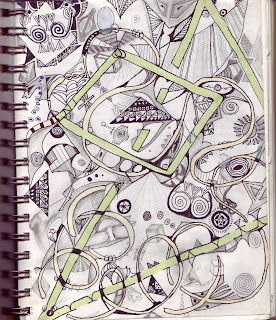All material on this blog has been copyrighted. Use any materials therein without permission and risk civil liability as applicable under your countries copyright laws.
Share this
Friday, November 12, 2021
Thursday, November 11, 2021
Warping light
Saturday, May 22, 2021
Artificial Intelligence
Tuesday, May 12, 2020
White Guy Diary: The Cultural Appropriation Edition
How can we reconcile the anthropological concept of cultural diffusion with the arising critique of the practice of cultural appropriation? I will never argue against the idea that systematic oppression exists, or that it marks with trauma wherever it goes, but the instinct to always protect against hurt -- a noble one surely -- is it always in our best interests? When I was hurt, I knew where my cards lay, where others' cards lay, so I could best play the hand I'd been dealt. The asymmetrical power of a host and a minority culture makes the profiteering off the minority culture certainly odious in a Marxist framework of understanding.
Critiques of cultural appropriation tend to be morally consequentialist. That is, they focus more on the outcomes of actions and behaviour, rather than on the motivations and intents of the actors in such actions and behaviour. They argue that the harm done to those traumatized by oppression by these images, by the act of appropriating culture, often rooted in rude parody, taken up by the host culture renders them morally suspect at best and simply morally wrong at worst. They tend to discount the intent of any member of the host culture as insignificant to their moral calculus, to use a term of William Vollmann's. Certainly the appropriation of cultural practices can come out of a place of respect, admiration, and love. But by sacralizing the trauma of the oppressed's experience, by prioritizing theoretical future pain against any notion of beneficial intent, they reify it and make it harder to overcome. I tend to lean consequentialist, but I must admit outright eliminating considerations of intent makes me uncomfortable. But who knows. . .perhaps this is white fragility, and perhaps they are right.
We cannot be killed with even a thousand paper cuts. On the other hand, pain is an obstacle to pragmatic organizing in anti-oppression work. Humans have always learned from each other; learning is always an appropriation. How am I, as a white guy, supposed to engage this great "shut-up and listen" exercise, without being somehow influenced by what I hear, by taking it to heart (too much, some will whisper to each other behind their backs). And hasn't this "taking it to heart" affected me, consciously and unconsciously, such that I might not appropriate that culture without any conscious intent at all, but simply through the processes of psychological sublimation and Freudian slips? Does this not produce a cyclical relationship between host and minority, where I listen, learn, appropriate, then lose the cultural war? Nobody likes losing all the time. Cultural diffusion: contact produces sharing, whether you like it or not.
One thing that irks me about cultural appropriation debates is how inconsistently they are applied. A straight, white man writing through the voice of a black woman is a no-no, but a Korean family in Toronto opening a Sushi shop is a-ok. Again, here is where the asymmetrical power card comes in handy, because we can aver that the Korean family is making a peer-to-peer cultural appropriation, whereas the white man, even if he is "raising awareness" of issues faced by black women, is making a downward appropriation. No Korean family is going to chastise a white guy eating in their restaurant, no matter how blatant a downward appropriation it is because you don't bite the hand that feeds you. The irony cuts both ways. That Korean family could not give a flying $^$# about cultural theorists' arguments about appropriation, or they might have a college-going child who does, at most.
Saturday, May 09, 2020
Wednesday, May 06, 2020
Friday, December 08, 2017
Piling up in the meadow.








